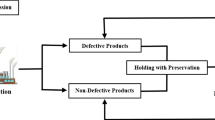Abstract
We consider two-stage stochastic linear production planning problems with partial cooperation including resource pooling, technology transfer and product transshipment, and employ a two-stage programming model with simple recourse to address uncertain demands. At the first stage, each manufacturer individually determines the production level according to its own technology and transferred technologies. After the demands are realized, multiple manufacturers jointly produce the products using pooled resources, and surplus products are transshipped to manufacturers with residual demands. Using the core solution concept from cooperative game theory, the additional profit obtained at the second stage is divided among all manufacturers. We develop a method to find a Nash equilibrium point such that the sum of the profits earned by all manufacturers is maximized. To demonstrate the validity of the proposed model, numerical examples are presented.


Similar content being viewed by others
References
Anupindi, R., Bassok, Y., & Zemel, E. (2001). A general framework for the study of decentralized distribution systems. Manufacturing & Service Operations Management, 3, 349–368.
Bauso, D., & Timmer, J. (2009). Robust dynamic cooperative games. International Journal of Game Theory, 38, 23–36.
Bird, G. C. (1976). On cost allocation for a spanning tree: A game theoretic approach. Networks, 6, 335–350.
Birge, J. R., Louveaux, F. (1997). Introduction to stochastic programming. Springer.
Charnes, A., & Granot, D. (1976). Coalitional and chance-constrained solutions to \(n\)-person games. I: The prior satisficing nucleolus. SIAM Journal on Applied Mathematics, 31, 358–367.
Charnes, A., & Granot, D. (1977). Coalitional and chance-constrained solutions to \(n\)-person games, II: Two-stage solutions. Operations Research, 25, 1013–1019.
Chen, X., & Zhang, J. (2009). A stochastic programming duality approach to inventory centralization games. Operations Research, 57, 840–851.
Chen, X., & Zhang, J. (2016). Duality approaches to economic lot-sizing games. Production and Operations Management, 25, 1203–1215.
Curiel, I., Derks, J., & Tijs, S. (1989). On balanced games and games with committee control. OR Spektrum, 11, 83–88.
Danzig, G. B. (1955). Linear programming under uncertainty. Management Science, 1, 197–206.
Dubey, P., & Shapley, L. S. (1984). Totally balanced games arising from controlled programming problems. Mathematical Programming, 29, 245–267.
Engelbrecht-Wiggans, R., & Granot, D. (1985). On market prices in linear production games. Mathematical Programming, 32, 366–370.
Fang, X., & Cho, S.-H. (2014). Stability and endogenous formation of inventory transshipment networks. Operations Research, 62, 1316–1334.
Feltkamp, V., van den Nouvceland, A., Borm, P., Tijs, S., & Koster, A. (1993). Linear production with transport of products, resources and technology. ZOR-Methods and Models of Operations Research, 38, 153–162.
Fernández, F. R., Fiestras-Janeiro, M. G., García-Jurado, I., & Puerto, J. (2005). Competition and cooperation in non-centralized linear production games. Annals of Operations Research, 137, 91–100.
Granot, D. (1986). A generalized linear production model: A unifying model. Mathematical Programming, 34, 212–222.
Granot, D., & Huberman, G. (1981). Minimum cost spanning tree games. Mathematical Programming, 21, 1–18.
Granot, D., & Huberman, G. (1984). On the core and nucleolus of M. C. S. T. games. Mathematical Programming, 29, 323–347.
Granot, D., & Sošić, G. (2003). A three-stage model for a decentralized distribution system of retailers. Operations Research, 51, 771–784.
Gutiérrez, E., Llorca, N., Sánchez-Soriano, J., & Mosquera, M. A. (2017). Equilibria in a competitive model arising from linear production situations with a common-pool resource. TOP, 25, 394–401.
Kalai, E., & Zemel, E. (1982). Totally balanced games and games of flows. Mathematics of Operations Research, 7, 476–478.
Kalai, E., & Zemel, E. (1982). Generalized network problems yielding totally balanced games. Operations Research, 30, 998–1008.
Kall, P., & Mayer, J. (2005). Stochastic linear programming models, theory, and computation. Springer.
Megiddo, N. (1978). Cost allocation for Steiner trees. Networks, 8, 1–6.
Megiddo, N. (1978). Computational complexity and the game theory approach to cost allocation for a tree. Mathematics of Operations Research, 3, 189–196.
Nishizaki, I., Hayashida, T., & Shintomi, Y. (2016). A core-allocation for a network restricted linear production game. Annals of Operations Research, 238, 389–410.
Nishizaki, I., & Sakawa, M. (2000). Fuzzy cooperative games arising from linear production programming problems with fuzzy parameters. Fuzzy Sets and Systems, 114, 11–21.
Nishizaki, I., & Sakawa, M. (2001). On computational methods for solutions of multiobjective linear production programming games. European Journal of Operational Research, 129, 386–413.
Owen, G. (1975). On the core of linear production games. Mathematical Programming, 9, 358–370.
Özener, O. Ö., Ergun, Ö., & Savelsbergh, M. (2013). Allocating cost of service to customers in inventory routing. Operations Research, 61, 112–125.
Samet, D., & Zemel, E. (1984). On the core and dual set of linear programming games. Mathematics of Operations Research, 9, 309–316.
Sandsmark, M. (1999). Production games under uncertainty. Computational Economics, 14, 237–253.
Shinbun, Y. (2020). Carpool delivery, beer and food industries are ahead. The Japan News, August 19. (in Japanese)
Suijs, J. (2000). “Nucleoli for stochastic cooperative games’’, Cooperative decision-making under risk (pp. 63–87). Norwell.
Suijs, J. (2000). “Price uncertainty in linear production situations’’, cooperative decision-making under risk (pp. 107–121). MA, Kluwer: Norwell.
Suijs, J., & Borm, P. (1999). Stochastic cooperative games: superadditivity, convexity, and certainty equivalents. Games and Economic Behavior, 27, 331–345.
Suijs, J., Borm, P., De Waegenaere, A., & Tijs, S. (1999). Cooperative games with stochastic payoffs. European Journal of Operational Research, 113, 193–205.
Tamir, A. (1991). On the core of network synthesis games. Mathematical Programming, 50, 123–135.
The daily industrial news, Seven companies such as Runesas and Toshiba collaborate in semiconductor production in the event of a disaster. Newswitch September 23, 2016. (in Japanese)
Timmer, J., Borm, P., & Suijs, J. (2000). Linear transformation of products: games and economies. Journal of Optimization Theory and Applications, 105, 677–706.
Toriello, A., & Uhan, N. A. (2014). Dynamic cost allocation for economic lot sizing games. Operations Research Letters, 42, 82–84.
Toriello, A., & Uhan, N. A. (2017). Dynamic linear programming games with risk-averse players. Mathematical Programming, 163, 25–56.
Uhan, N. A. (2015). Stochastic linear programming games with concave preferences. European Journal of Operational Research, 243, 637–646.
Walkup, D. W., & Wets, R. (1967). Stochastic programs with recourse. SIAM Journal on Applied Mathematics, 15, 139–162.
Wets, R. (1974). Stochastic programs with fixed recourse: The equivalent deterministic program. SIAM Review, 16, 309–339.
Acknowledgements
This work was supported by JSPS KAKENHI Grant Numbers: 18K18923 and 21H01565.
Author information
Authors and Affiliations
Corresponding author
Additional information
Publisher's Note
Springer Nature remains neutral with regard to jurisdictional claims in published maps and institutional affiliations.
Rights and permissions
Springer Nature or its licensor (e.g. a society or other partner) holds exclusive rights to this article under a publishing agreement with the author(s) or other rightsholder(s); author self-archiving of the accepted manuscript version of this article is solely governed by the terms of such publishing agreement and applicable law.
About this article
Cite this article
Nishizaki, I., Hayashida, T., Sekizaki, S. et al. A two-stage linear production planning model with partial cooperation under stochastic demands. Ann Oper Res 320, 293–324 (2023). https://doi.org/10.1007/s10479-022-05056-w
Accepted:
Published:
Issue Date:
DOI: https://doi.org/10.1007/s10479-022-05056-w




